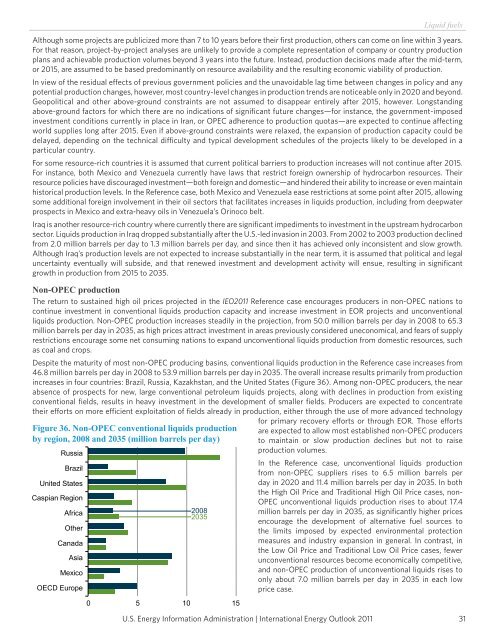International Energy Outlook 2011 - EIA
International Energy Outlook 2011 - EIA
International Energy Outlook 2011 - EIA
You also want an ePaper? Increase the reach of your titles
YUMPU automatically turns print PDFs into web optimized ePapers that Google loves.
U.S. <strong>Energy</strong> Information Administration | <strong>International</strong> <strong>Energy</strong> <strong>Outlook</strong> <strong>2011</strong><br />
Liquid fuels<br />
Although some projects are publicized more than 7 to 10 years before their first production, others can come on line within 3 years.<br />
For that reason, project-by-project analyses are unlikely to provide a complete representation of company or country production<br />
plans and achievable production volumes beyond 3 years into the future. Instead, production decisions made after the mid-term,<br />
or 2015, are assumed to be based predominantly on resource availability and the resulting economic viability of production.<br />
In view of the residual effects of previous government policies and the unavoidable lag time between changes in policy and any<br />
potential production changes, however, most country-level changes in production trends are noticeable only in 2020 and beyond.<br />
Geopolitical and other above-ground constraints are not assumed to disappear entirely after 2015, however. Longstanding<br />
above-ground factors for which there are no indications of significant future changes—for instance, the government-imposed<br />
investment conditions currently in place in Iran, or OPEC adherence to production quotas—are expected to continue affecting<br />
world supplies long after 2015. Even if above-ground constraints were relaxed, the expansion of production capacity could be<br />
delayed, depending on the technical difficulty and typical development schedules of the projects likely to be developed in a<br />
particular country.<br />
For some resource-rich countries it is assumed that current political barriers to production increases will not continue after 2015.<br />
For instance, both Mexico and Venezuela currently have laws that restrict foreign ownership of hydrocarbon resources. Their<br />
resource policies have discouraged investment—both foreign and domestic—and hindered their ability to increase or even maintain<br />
historical production levels. In the Reference case, both Mexico and Venezuela ease restrictions at some point after 2015, allowing<br />
some additional foreign involvement in their oil sectors that facilitates increases in liquids production, including from deepwater<br />
prospects in Mexico and extra-heavy oils in Venezuela’s Orinoco belt.<br />
Iraq is another resource-rich country where currently there are significant impediments to investment in the upstream hydrocarbon<br />
sector. Liquids production in Iraq dropped substantially after the U.S.-led invasion in 2003. From 2002 to 2003 production declined<br />
from 2.0 million barrels per day to 1.3 million barrels per day, and since then it has achieved only inconsistent and slow growth.<br />
Although Iraq’s production levels are not expected to increase substantially in the near term, it is assumed that political and legal<br />
uncertainty eventually will subside, and that renewed investment and development activity will ensue, resulting in significant<br />
growth in production from 2015 to 2035.<br />
Non-OPEC production<br />
The return to sustained high oil prices projected in the IEO<strong>2011</strong> Reference case encourages producers in non-OPEC nations to<br />
continue investment in conventional liquids production capacity and increase investment in EOR projects and unconventional<br />
liquids production. Non-OPEC production increases steadily in the projection, from 50.0 million barrels per day in 2008 to 65.3<br />
million barrels per day in 2035, as high prices attract investment in areas previously considered uneconomical, and fears of supply<br />
restrictions encourage some net consuming nations to expand unconventional liquids production from domestic resources, such<br />
as coal and crops.<br />
Despite the maturity of most non-OPEC producing basins, conventional liquids production in the Reference case increases from<br />
46.8 million barrels per day in 2008 to 53.9 million barrels per day in 2035. The overall increase results primarily from production<br />
increases in four countries: Brazil, Russia, Kazakhstan, and the United States (Figure 36). Among non-OPEC producers, the near<br />
absence of prospects for new, large conventional petroleum liquids projects, along with declines in production from existing<br />
conventional fields, results in heavy investment in the development of smaller fields. Producers are expected to concentrate<br />
their efforts on more efficient exploitation of fields already in production, either through the use of more advanced technology<br />
Figure 36. Non-OPEC conventional liquids production<br />
by region, 2008 and 2035 (million barrels per day)<br />
Russia<br />
Brazil<br />
United States<br />
Caspian Region<br />
Africa<br />
Other<br />
Canada<br />
Asia<br />
Mexico<br />
OECD Europe<br />
2008<br />
2035<br />
0 5 10 15<br />
for primary recovery efforts or through EOR. Those efforts<br />
are expected to allow most established non-OPEC producers<br />
to maintain or slow production declines but not to raise<br />
production volumes.<br />
In the Reference case, unconventional liquids production<br />
from non-OPEC suppliers rises to 6.5 million barrels per<br />
day in 2020 and 11.4 million barrels per day in 2035. In both<br />
the High Oil Price and Traditional High Oil Price cases, non-<br />
OPEC unconventional liquids production rises to about 17.4<br />
million barrels per day in 2035, as significantly higher prices<br />
encourage the development of alternative fuel sources to<br />
the limits imposed by expected environmental protection<br />
measures and industry expansion in general. In contrast, in<br />
the Low Oil Price and Traditional Low Oil Price cases, fewer<br />
unconventional resources become economically competitive,<br />
and non-OPEC production of unconventional liquids rises to<br />
only about 7.0 million barrels per day in 2035 in each low<br />
price case.<br />
31

















